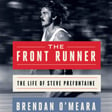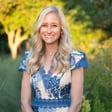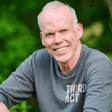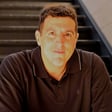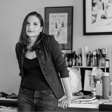Become a Creator today!Start creating today - Share your story with the world!
Start for free
00:00:00
00:00:01

Episode 276: Earl Swift Takes Us to the Moon
Earl Swift, author of Across the Airless Wilds: The Lunar Rover and the Triumph of the Final Moon Landings, returns to talk about his latest book.
Sponsor help: West Virginia Wesleyan College's MFA in Creative Writing
Membership: patreon.com/cnfpod
Social Media: @CNFPod
Transcript
The Value of Returning Guests
00:00:00
Speaker
Some people don't have guests back on their shows, and I don't know what that's about. There's immense value in having guests back on the show because you pick into things in greater detail. Instead of tracing just a single arc of a career, you can only talk about origins once, right? More or less.
00:00:21
Speaker
And so it is with Earl Swift, who is back on the show after a three year absence. Come on. How the hell did that happen? Who are you? Who am I? Where are we? What year is it?
Introduction to Earl Swift and His New Book
00:00:37
Speaker
One things for certain is the Creative Nonfiction podcast, the show where I speak to badass people about the art and craft of telling true stories. I'm Brendan O'Mara. Hello.
00:00:48
Speaker
at CNF pod or at Brendan O'Mara on Twitter and Instagram. Earl is back to talk about his new book, Across the Airless Wilds, The Lunar Rover and the Triumph of the Final Moon Landings. It's published by Custom House, which is an imprint of Harper Collins, such as my understanding. This conversation hinges mightily on this book and this book alone.
00:01:14
Speaker
One of those great benefits to having repeat guests on the show when they have something new to talk about is that you can just talk about that thing instead of, I don't know, just going over ancillary things.
Themes in 'Across the Airless Wilds'
00:01:30
Speaker
So we dig into the regolith man, which I mistakenly call the regolith, which is the surface of the moon, such is my understanding. If you believe they put a man on the moon,
00:01:41
Speaker
You'll love this book. Support for the Creative Nonfiction podcast is brought to you by West Virginia Wesleyan College's low residency MFA in creative writing. Now in its 10th year, this affordable program boasts a low student-to-faculty ratio and a strong sense of community. Recent faculty, CNF faculty, include random Billings Noble, Jeremy Jones, and CNF pod alum Sarah Einstein.
00:02:06
Speaker
There's also fiction and poetry tracks. Recent faculty there include Ashley Bryant Phillips and Jacinta Townsend, as well as Diane Gilliam and Savannah Sipple. No matter your discipline, if you're looking to up your craft or learn a new one, consider West Virginia Wesleyan right in the heart of Appalachia. Visit nfa.wvwc.edu for more information and dates of enrollment.
00:02:30
Speaker
What I just realized about reading that website is that it is literally just letters. I'm just realizing that now. Oh boy. Consider supporting the show via Patreon. Patreon.com slash CNFpod. Shop around. If you want to support the community and keep the lights on at CNFpod HQ, I just paid out the writers from the last audio magazine. You make that possible. The show is free, but it ain't cheap.
00:02:58
Speaker
Go away, shop around. There's transcripts of which I'm horribly behind on. I'm sorry, I'm working on it. Can ask questions of guests and so forth. I put out things, sometimes I put exclusive things into the Patreon community. Audio magazine, transcripts, coaching, you name it. Head over there. CNF, patreon.com slash CNF pod.
00:03:19
Speaker
A little more about Earl.
Earl's Background and Writing Journey
00:03:21
Speaker
He is the author of Chesapeake Requiem, Autobiography, and several others. And here's a little ditty from his website. He began writing for a living in his teens in the years since the Virginia-based journalist has penned seven books and hundreds of major features for newspapers and magazines and has earned a reputation for fast-moving narrative and scrupulous reporting.
00:03:43
Speaker
He has been nominated for the National Book Award, the National Magazine Award, and seven times for that little-known prize, the Paltter Prize. And you know what? He lives a mile from the Appalachian Trail and hikes five miles a day on it. Awesome stuff. He's at Earlswift.com, at Earlswift Numeral One on Twitter, and he's back on the show right now.
00:04:23
Speaker
what what it was like writing this book as the as the pandemic was you know in in the throes of when you were in the throes of pandemic how you know writing this book was well what kind of a challenge that was for you in some way say that I was you know the least affected person I knew by from the pandemic because I I would have been chained to my keyboard regardless it was a
00:04:50
Speaker
I was lucky I started work on the project in the spring of 2019 and got all the reporting, offsite reporting done in 2019. Might've made a couple of additional trips in 2020, had the opportunity presented itself. But then from, you know, really December of 19 on, I had a tremendous amount of organization
00:05:20
Speaker
and writing to do that kept me busy until my first draft was due on June 1st of last year. And then I took it through five additional drafts over the summer and early fall. And so I really worked all the way through it. And then there's an awful lot of post-production that comes along that
00:05:44
Speaker
that you think would, you know, would not take all that, um, but takes almost as long as writing the book does. And, um, you know, by the time I finally, I guess the, the heavy lifting that, you know, the, the real work, uh, the necessary work on the book was finished in February. I was allowed to make changes up until early April and then the book came out July. So it was, it was right up to the
00:06:12
Speaker
like the day before the book went to the printer, I was still in the manuscript. You said that the drafting process was upwards of five different drafts. So over the course of the synthesis of this book, how did the book change during those drafts? What were you cranking on through those revisions? Well, six drafts total. I think that
00:06:40
Speaker
The second, I mean, the book in its first draft form was probably not as well focused. It was probably a bit long in the middle and slowed down more than I liked. So the second through fourth draft say, those really consisted of doing more reporting, filling out pieces of the book that I thought
00:07:09
Speaker
I needed more attention and cutting. I cut a lot. Just trying to increase the forward propulsion of the reading experience. Another thing that happened along the way, initially, the book had 16 chapters. A good friend of mine, who is my first reader, the name of Laura Lasset, anyone who needs an editor,
00:07:38
Speaker
I can recommend her. She lives in Richmond. I can put them in touch with her. She both had the same reaction, which was that somehow the book just felt disjointed. The chapters were 5,000 words long on average, and they just covered an awful lot of ground. Each one was a pot full of disparate elements, and Laura actually
00:08:02
Speaker
came to me one day or phoned me up and said, you know, I think I figured out what, what the problem is. And I've just divided the story into a lot more chapters, haven't changed the word, but I've just split it up. And I said, how many chapters did you divide it into? And she said 48. Well, I remember I laughed out loud. I said, there's no way you'd like to write a book with 48 chapters. But then when I went back through and saw what she'd done, I realized, yeah, she was truly onto something. And, and,
00:08:30
Speaker
I took it further and the book is finished as 66 chapters. Some of them very short, some of them pretty meaty. But it definitely took care of that problem, which was one of the big issues in writing this book. There are a lot of moving parts to the story. And just presenting them in a way that doesn't leave the reader drowning is a challenge. It's a technical story. It's a human story.
00:09:01
Speaker
The story I will say I took great pains to tell in without using any jargon whatsoever You know, I use none of the typical NASA acronyms except to make fun of them. So it's uh, you know, it was it was a real challenge because but you know the Book the story the book tell is a story that we all know at least in part But we we think we do anyway
00:09:28
Speaker
People don't remember the last three moon landings well, but they have some vague recollection of them. I think most of them have a certain age. They dim considerably in the shadow cast by Apollo 11. But I think that most people have some grasp
Significance of the Apollo Missions
00:09:44
Speaker
that they were different and that they were different for one typically American piece of gear that the astronauts carried with them on those last three missions. And that is they carried a car.
00:09:55
Speaker
what I think is is not remembered so well is just what a transformative difference that seemingly gimmicky piece of gear had on everything about those missions and just the quantum leap in capability that they represented because largely because of that addition. So you know it once I got into the story thinking I knew it pretty well and
00:10:22
Speaker
and found the deeper I got into it that I didn't know it well at all. And especially what I didn't know was that these last three Apollo missions were so different from everything that came before that you could argue, and I do in the book, that every piece of the American space program up to that point, going all the way back to Alan Shepard's first flight to Mercury capsule in 1961,
00:10:51
Speaker
All of that was preparation for these last three Apollo missions. All of it was developmental, aiming at what these – finally kind of getting good at it, which we did in these last three.
00:11:05
Speaker
Yeah, it's so it's so illustrative of what you're able to do that every mission was building on the previous one. So even the first it's like as soon as they land the first rover on the moon, they're already like iterating reiterating how to what iterating again to.
00:11:24
Speaker
Like, all right, what can we do to tweak this, this, that, and the other? Because you can only do so much testing in Arizona in some volcanic field or wherever you are. There's no replication for getting 200 some odd thousand miles away on the moon. So it's almost like every tire rotation is just another data point. They're like, okay, this is how we can turn the ratchet a little more and make this even better.
00:11:53
Speaker
Oh yeah, and you know they did that. NASA was pretty famous for that sort of thing. In the rover, you brought up something that really is kind of strange about that particular piece of technology, which is it's really the one piece of Apollo hardware that could not be tested on Earth.
00:12:14
Speaker
because this is a machine that is built for one sixth gravity. It was so gossamer light and construction that if an astronaut had stepped onto its floorboard on earth, he would have broken the thing in half. You had to wait until you got to the moon to really suss out how it would work. And, you know, the astronauts were able to do some driver's ed in the volcanic crater fields outside Flagstaff that you mentioned.
00:12:40
Speaker
They were able to get some idea of how they use the rover in building sorties. They were able to plan their science pretty well on Earth, driving much beefier versions of the rover built for Earth travel. But the actual machine was untested until Dave Scott and Jim Irwin, Apollo 15, lowered it from the side of the lunar module and climbed aboard.
00:13:10
Speaker
pretty phenomenal. You could argue that that first sortie on Apollo 15, that first short, well, it wasn't so short, first ride, two hour and 16 minute drive that Scott and Erwin took, was kind of the end of the development phase of Apollo. That was the last point at which they were testing here, testing procedures, you know, in preparation for the next mission. Because with the very next drive, now they know the rubber works. Now they know it works even better than average time.
00:13:39
Speaker
And you see, in real time, mission control changing the shape of their travels and their explorations to take advantage of this new piece of equipment. It's remarkable. You hear this all the time, but it's remarkable that all of this was accomplished without what we'd consider modern computing power.
00:14:03
Speaker
No, this is all slide rules and chalkboards. It's just, it's inspiring. Oh, it was so fascinating and just the brilliant minds behind it and the fact that you're, like, you know, we're, you know, they're
00:14:19
Speaker
Like, you can't simulate the moon, like you were saying. There were only so much driver's head you could do on Earth, but it would still... Even sitting in the driver's seat here on Earth, it is still so hypothetical, and there was no way to know what would happen until you got...
00:14:37
Speaker
onto the moon. It blows my mind the stress these scientists and engineers must have been under. Up until the final moments of it, just the incredible stress and pressure, it just must have been harrowing to witness and for you to even report on it from some of the people who are still alive. Yeah, I mean they were all on the edge of their seats and I got lucky.
00:15:06
Speaker
an amazing number of of those guys are still alive and You know, I was I was fortunate enough to Define them not only willing to talk to me, but pretty eager to tell the
Research and Crafting Technical Narratives
00:15:20
Speaker
story which Oddly had not really been told in any kind of detail before there. There are a couple of British books in one case rovers in general It takes in the the Mars rovers and such robotic rovers they came after
00:15:35
Speaker
And in the other case, a kind of a mock shop manual for the rover, a Hanes manual repair guide. At least that's what it looks like on the cover. When you open it up, it's a picture book. But neither got into the subject and neither one of them told this story. They gave all sorts of technical data on the machines and there were some interesting, you know,
00:16:05
Speaker
descriptions of their development. But none of that was related in a story that I wanted to read anyway. I mean, I read them because I had to as preparation, but they weren't books that I would have picked up. And so there was room, not only for the first American book on the subject, but for the first book that tried to put it in narrative form and really kind of unspool
00:16:36
Speaker
the story going back to its very beginning, which of course was way earlier than I think most people, including me, had any idea about. The reporting, as is always the case, was 90% of the fun. I spent not only time talking to the folks in person, but then after going through the records of the Marshall Space Flight Center
00:17:04
Speaker
at the National Archives in Atlanta and some of the personal papers of the engineers involved at the University of Alabama, Huntsville. I had a lot of follow-up questions for those engineers and spoke with many of them on the phone many times. Found that they had really sharp recollection of meetings and mishaps 50, 55 years ago and that they were
00:17:34
Speaker
as excited when I talked to them about the project, I think as they were, well, maybe not quite as much, but close to as excited as they were when it was actually happening. This was something that they spent years on. And for many of them, it was the zenith of their careers. And they wanted to get the story out there.
00:17:56
Speaker
What became the challenge for you to make this a narrative that reads, that is reader friendly, given that so many of the sources that you're talking to, you know, are engineers and scientists who sometimes don't necessarily have a flair for this, a flair for narrative, but very technical, but not narrative. So what was that challenge for you to, you know, make this readable and not just like, you know, jargon laden like you were saying earlier?
00:18:26
Speaker
Well, well, one thing about engineers, I will say, they have a terrible reputation. You know, it's pretty dismal. Working around with pocket protectors and whatnot. But what I've found is that the good ones are enormously creative. They're problem solvers, you know, they may not articulate that creativity in narrative form. But the fact is that there's a bright light burning in there. And, and all you have to do is figure out how to get to it.
00:18:54
Speaker
And, you know, then what I found was in the course of conversation with them, the deeper you go, the better it gets. You know, once they realize that you're interested in writing deep, that gets them excited and they, they'll take you as deep as you want to go. And, uh, you know, one of the challenges in this story was that, uh, you know, the Rover project involved hundreds of people, the Apollo program.
00:19:23
Speaker
Involved 400,000 people working for the government and for private contractors. And so job number one is figuring out the basic parameters of the story. Where does this thing begin? And what is the arc that it follows? And then who are the players that you concentrate on? Who's your task going to be to get you across that arc? And I was lucky that I had a lot of people to choose from.
00:19:53
Speaker
and was able to find four or five main players who really carried the story from beginning to end, and take you from the earliest abstract kind of thinking about moving around on the moon to the actual leaving tire tracks there. So really, you wind up, when you get back from the archives,
00:20:21
Speaker
with just a mountain of paper, in my case, scanned documents, mountain of files, you know, you just got to figure out what you have first. And yeah, that that's, that's fun in a wonky kind of way. It's, it's the real work of, of the, of the project. I think that the real heavy lifting comes with just figuring out, okay, what do I have? What does it say?
00:20:50
Speaker
How does it feed in to a larger story? What is the shape of that story? Is it a story? Is that the story I want to tell? There are a lot of aids or shortcuts that have been developed in the past few years, programs that help writers organize their material, scrivener and programs such as that. And I have friends who have benefited greatly from using them. I'm not one of those
00:21:18
Speaker
Those guys, I find that it helps me to read a document in the archives, to read it while I'm scanning it, to read it back home when I'm going through my scans, to read it again when I'm trying to figure out how to file it, and to read it again when I dump it into my computer. I find that I wind up with a much better grasp of what it is that I have that way. And it's way slower. No question about that. It's molasses slow.
00:21:49
Speaker
but it works for me. Talk a little bit about Frank Pavlix. He was one of the more fascinating characters in this book, and I think he had passed away before you had started this project, so I don't think you had a chance to speak with him, but he did leave behind some documentation of his life and career, but he was a wildly fascinating guy. Frank Pavlix was alive and well, and I visited him with, I visited with him for
00:22:16
Speaker
Two days at his home in Santa Barbara and then spoke with him on the phone.
Key Figures in Lunar Mobility
00:22:20
Speaker
And then he did run into some health issues later. And so late in the project, I dealt with his son Peter as a go-between. And Peter was enormously helpful and was able to put me in touch with documents and photos that I needed to get ahold of. But Frank was a tremendously gracious guy.
00:22:46
Speaker
who wears the fact that he has lived a big and adventurous and at times terrifying life very lightly. Now, another figure, Frank's boss, who had passed away before I started the project was MG Becker, Greg Becker. Okay. And maybe I was mixing those two up. Yeah. But who's alive or dead? Becker's a guy who ought to be a
00:23:15
Speaker
household name at least among a significant portion of the population because if you've ever gone mudding in a Jeep or or raced motocross or gone mountain biking or driven a bulldozer or ridden in a tank you owe some of the experience to Greg Becker who invented the engineering discipline of paramechanics to study of the interaction between vehicles and the terrain over which they travel.
00:23:45
Speaker
His expertise, he spent most of his career applying that expertise to military use, to military vehicles and tanks and whatnot. And then late in his career, got interested in space and really wasn't drafted into it, just kind of acquired the interest on his own. Frank Pavlik's work for him is his protege, more or less. And so he recruited Frank into
00:24:15
Speaker
to helping him and together they did some of the earliest studies of moon mobility, trying to figure out what the surface of the moon would be like and what kind of vehicle, what kind of wheel, what kind of motive force would be best suited to getting you from point A to point B across that surface. And they did a lot of that early work at General Motors, which I think most people don't realize was involved in
00:24:45
Speaker
in Apollo, but it was involved pretty heavily. And General Murders was the de facto designer of the lunar rover that went to the moon.
00:24:56
Speaker
Yeah, and, you know, another fascinating character that you kind of start the book out with is the Werner von Braun, who had, you know, an interesting past in Germany and somewhat nebulous circumstances, but he was, again, a brilliant mind who, you know, came over and was one of several immigrants that were so integral to these early space flights.
00:25:23
Speaker
Yeah, Von Braun has a very problematic task. He was a not, you know, not he was an SS officer. He was complicit in the deaths of thousands of concentration camp prisoners, a war criminal who got lucky and was viewed by the government of the United States as more valuable alive than put on trial and executed. And so he was brought to the United States after the war with more than 100 of his German engineers.
00:25:52
Speaker
with whom he had designed the world's first ballistic missile the V2 which had bring terror on London and and for Belgium late in the war from September of 44 to March of 35 and You know that V2 that very early somewhat primitive Liquid fueled rocket in wildly modified form
00:26:22
Speaker
became the Saturn 5. The technology did not change much. It was refined. So Von Braun, of course, the father of American rockets, at least, practical rockets. For the purpose of this story, his real contribution is that he also was among the first people to really write futuristic nonfiction
00:26:50
Speaker
that centered on the importance of not only getting to the moon with crews, but getting them around the moon in some sort of vehicle. And he did that as early as 1952. Really pretty amazing stuff. And it seems to become more so all the time because if you look at some of the projections of what our future moon and Mars missions
00:27:17
Speaker
might look like. The projections being produced today. The rockets look a lot like the rockets that Von Braun envisioned back in 1952 as going to the moon. For all of his very troubling path, the man was a genius. And he was a genius especially at selling the idea of space and organizing an army of engineers to get there.
00:27:46
Speaker
He's a brilliant organizer. We, I think, would have reached the moon without him, but we wouldn't have done it in 1969. It might have been the 1980s before we got there.
Personal Memories and Apollo 15
00:28:00
Speaker
Do you have a strong memory of July 26, 1971?
00:28:07
Speaker
I have a sharper memory of July 31, 1971, when this is the day after the Apollo 15 crew landed on the moon in the Hadley-Apinine region of the moon. On that day, they unfolded the rover from the side of the lunar module and got in and drove off. And one of the reasons I have very little recollection of the missions that came before, I was
00:28:34
Speaker
My parents wouldn't let me stay up. We lived in England when Apollo 11 landed, made the first landing. And it was like five in the morning over there. And my parents wouldn't let me stay up to see that. So, you know, I remember them being very excited about it, but I didn't get to see it lively. And by 12, I have no recollection of whatsoever. 14, I remember only Alan Shepard hitting a golf ball at the end of the mission.
00:29:01
Speaker
Which I sadly is what I think most people remember about Apollo 14 But 15 by the time 15 came along I turned 13 the day they they landed and so I was a teenager freshly minted and a little bit more aware of what was going on around me and We had moved to Houston by then and so The space the space program was wall-to-wall. It was unavoidable. Yeah, and I
00:29:31
Speaker
But mostly I remember that they had the rover. And the rover did something that, beyond just taking the astronauts, increasing their range and increasing the time that they could stay outside, they had a TV camera that they brought with them. And that was the first time that had happened in Apollo. And the first three missions when the astronauts were on foot, the camera was stationary. It was on a tripod. It was on a tripod next to the lunar module.
00:29:59
Speaker
You might recall that there were images of blobs bouncing around on the lunar surface. The resolution was terrible. And they weren't doing anything particularly interesting, at least from what you could see on the camera. They were there. And that was the amazing part. But it wasn't great TV. And if they wandered off camera, they wandered off camera. The camera didn't follow. In the case of Apollo 14, they wandered off camera for a couple of hours during the most exciting piece of
00:30:29
Speaker
of that mission and we at home didn't get to see any of it. But beginning with Apollo 15, the TV camera was on the nose of the rover and it was controlled remotely from mission control in Houston. So the astronauts would drive and they'd reach a spot where they were supposed to do some prospecting or conduct some science. And an engineer named Ed Handel in Houston would take command of the camera
00:30:58
Speaker
and follow them as they conducted their work. Camera was a much better color, high resolution camera. And it was night and day, it was great TV. We got to follow the astronauts around as they crisscrossed the liver surface. And so I remember that, and I remember the succeeding two missions for the same reason, which was something that attracted me to the story. These are largely, these are the overlooked missions
00:31:27
Speaker
awful lot of the population. And yet the ones that we have the greatest documentation of, they're the ones we had the opportunity to witness firsthand to the greatest degree.
00:31:41
Speaker
but they came late in the program. And we were, yeah, we were jaded by that. Yeah, what struck me about the missions too was the importance of things that are seemingly so simple, but they were so integral, which were seatbelts and fenders. Yeah, it's absolutely the things that you might take for granted. They wouldn't have lasted 30 seconds without their seatbelt.
00:32:11
Speaker
One of the things that they had a good idea was probably going to happen, but they hadn't been able to experience it for themselves on Earth, was that when you take a vehicle that weighs less than 80 pounds in the moon's 1.6 gravity and you combine it with very, very rough terrain, you're going to have your wheels off the ground an awful lot of the time. You're going to be
00:32:40
Speaker
semi-airborne, a good piece of the time. Jim Erwin, who likened riding around in the Rover, is a cross between a bucking Bronco and a small boat in a heavy seat. You watch one piece of footage that we have of the Rover, you know, with an astronaut in it just going full out. That was on Apollo 16 when Charlie Duke filmed with a 16 millimeter camera, his commander, John Young,
00:33:10
Speaker
tearing around their landing site and the rover. You can see that the thing is bouncing all over the place, and often there are two or more wheels off the ground. So it was a handful to drive, but it changed everything. Because naturally, you would imagine that even at one horsepower, which was its total output, having wheels is going to give you
00:33:40
Speaker
legs, it's going to give you range to go a lot farther than you would. That effect was amplified by the Apollo spacesuit. The spacesuit weighed more than the man that wore it. He couldn't see his feet from inside his helmet. It was a bit like pulling on a dozen raincoats. Imagine just pulling on one raincoat over the next.
00:34:08
Speaker
And then having that heavy unyielding garment, pumped full of air to the stiffness of an all-season radial. And so that just bending your arm took real muscle. Closing your hand around a tool would exhaust your hands in minutes. So this thing was not easy to move around in. And because it took so much effort just to do the simple chores and to move, just to walk or bunny hop a short distance,
00:34:37
Speaker
the astronauts' metabolic rates while they were outside the lunar module, they were elevated almost the entire time. And that, in turn, burned through the cooling water in the air, the air supply, in their backpacks, which dictated how long they could stay outside the lunar module. So in addition to giving the astronauts range, the rover, because it gave them a cool down between every task,
00:35:04
Speaker
Again, because it removed their need to actually walk any significant distance. The rover enabled their metabolic rates to stay way down and stretched those supplies of air and cooling water to the point where they were able to stay outside the lunar module for fire longer and get a lot more done. So really, it had compounding benefits.
00:35:32
Speaker
that are easy to overlook when you see this bare bones, glorified go-kart. I mean, there's very little to it.
00:35:39
Speaker
Yeah, except when you put it, when you realize that this thing is attached to some, you know, spaceship, and then it has to get deployed, you know, up on the moon, and then you're like, all right, this thing is, it's amazing that it just gets up there without, I don't know, without breaking, and then it's, and there it is, a little primitive four-wheeler, but it's way the heck up there on the regolith.
00:36:06
Speaker
Amazing that they were able to get it small enough to fit in that spacecraft. And that really is an example of Frank Pavlik's genius right there because he came up with the solution. How do you get a car small enough to fit into a space about the size and shape of a pup tent standing on its end? So if we're talking about a space of about the same cubic footage
00:36:36
Speaker
as the way back of a full-size station wagon of the day, of the late 60s, early 70s. Those were big station wagons, but that's still a pretty small space to try to get a folded car into. But Frank Pavlik, he came up with a way to fold this thing like a business letter and then fold it again so that it formed a shape just like a pump tent, and it fit perfectly into that slot on the lower half of the lever module.
00:37:05
Speaker
I love that on the near sort of catastrophic seatbelt incident. It's a good thing that they were like, let's figure out how to tie this thing up so we can use it. As a result, they were able to find a pretty monumental piece of geology in this black basalt that was subsequently named the Seatbelt Basalt, which
00:37:29
Speaker
you know, gave a real indication of how, you know, old a lot of the geology and the life of the moon is. Well, the seat belt basalt was a piece of subterfuge by Dave Scott in Apollo 15. He was driving the rubber back to the lunar module after they made their last science stop and they had a lot of work to do outside the back of base camp.
00:37:57
Speaker
And he saw this black rock sitting out in the middle of the white lunar plane. And he decided, I want to get that rock. He knew that mission control would not let him stop, even as brief a stop as it would take to grab the thing and go. He knew they'd say no. So he faked that he was having trouble with his seat belt and bought himself about 30 seconds to jump off the rubber, run over, grab the seat belt that felt
00:38:27
Speaker
bring it back, stow it. And the whole time Jim Irwin was, you know, had launched into a monologue to cover him. And once he got back in on mission control last seatbelt, okay. And he goes, yeah, yeah, yeah, we're good. They continued on their way, but they, you know, the seatbelt, the Apollo 15 crew had trouble with their seatbelts because they, they were not easy. Again, because the, largely because the, the spacesuits they wore,
00:38:54
Speaker
didn't enable you to really see what you were doing down by your lap. You couldn't see what you were fiddling with when you were trying to connect the belt. And the other complicator was that when an astronaut was on Earth and they inflated his suit, they pressurized his suit. It got big and fat. It was pressurized. But then you take that up to the moon, which is essentially without atmosphere.
Challenges with Lunar Rover Design
00:39:24
Speaker
And it gets a lot bigger. The suit is actually bigger on you. It puffs up more. You're fatter than that. And that was a complication with the seat belt to pay. They hadn't foreseen probably, but they got it fixed in time for Apollo 16. It really wasn't a threat by any means at any point to Apollo 15.
00:39:52
Speaker
the fenders earlier some fender fender dramas on the on these missions what happened with those was a threat and you know we look at the moon from here and it's silvery it looks light almost white in color you get up there and and scoop up a handful of regolith and it's charcoal gray almost black and
00:40:18
Speaker
Without the fenders on the rubber, because the wheels, probably the signature feature of this machine, the wheels were made out of wire mesh, they tended to kill the soil as well as grip it. And they would pick up an arcing rooster tail of lunar soil as you drove along. Now we're talking a vehicle that's moving at most about eight miles an hour. Most of the time they were cruising along at about five or six miles an hour, even so.
00:40:48
Speaker
it would throw a huge amount of this lunar dust forward. And if you don't have fenders, that dust immediately settles. It doesn't hang in the air like it would here. There is no air for it to hang in. So it immediately falls on the astronauts and onto the delicate electronics controlling the rover's drive systems. It falls on their batteries. All the stuff, they can't afford to overheat. Because it's black, it absorbs heat, and it
00:41:18
Speaker
It threatens to trump the temperature management system that the rover has built into it, which is an unsexy component of this machine, but it's one of the most important components there is. On two missions, on Apollo 16 towards the end of the mission, John Young accidentally hooked the leg of his spacesuit
00:41:43
Speaker
on a fender extension. The fenders had extensions that slid so that they could fold up. The rubber could fold up and these things wouldn't get in the way. He snapped it off and so the right rear wheel was without, essentially without a fender. And those guys just got completely covered in soil and sort of the electronics and they had to spend a lot of time stopping to brush off all of their gear and brush themselves off as well.
00:42:14
Speaker
And then in Apollo 17, Gene Cernan gets out of the lunar module and less than an hour and a half, hour and 40 minutes after getting out. He does exactly the same thing that John Young did. Snaps that fender extension off on the same wheel. And he goes, Oh, you won't believe it. He do exactly how serious it was because now this is before the mission has really even started. And Apollo 17 had a very ambitious.
00:42:44
Speaker
menu of things that they were supposed to do, and it involved a lot of driving. As it happened, those guys drove more than 22 miles on the lunar surface, and they were in a crazy piece of, just a crazy setting. They were on an undulating plane, and their long drive of the mission, which was more than 12 miles by itself, called on them to
00:43:12
Speaker
drive across the central leaving plain, climb a fairly steeply sloping avalanche fan at the foot of a mountain. At the top of that avalanche fan, they'd come to the point where it met a 250-foot tall, give or take, raised geological faults, ridge-like structure across the valley. And they were going to drive through a notch in that fault
00:43:40
Speaker
and then down the other side. And they were supposed to do some sample collection at the base of a mountain on the other side of it. Now, at that point, they would be just shy of five miles from the lunar module and be on site of their one-way home, which is remarkable all by itself. But Cernan, as soon as he broke off, the fender realized there's no way you can make a drive like that with a fender machine.
00:44:04
Speaker
They'd have to stop every 10 minutes to brush off everything. They'd never get there. And they wouldn't have enough air and cooling water in their backpacks to get back again if they did. So it was an emergency. And luckily, he tried to tape the fender extension back on and it held for a brief while, enough for them to make a very short drive out to collect some samples and come back. And it fell off on their way back. And it remains wherever it fell today.
00:44:32
Speaker
So they had to come up with a replacement fender for the second draft, a long one. And with the help of a team in Houston at Mission Control led by John Young, the same guy who had broken the fender in Apollo 16, they came up with a fix, which was four US Geological Survey topo maps, which were laminated, duct taped together, and then clipped to the remaining part of the fender with some
00:45:02
Speaker
kind of put anywhere lamp clips from inside the little module and it looked awful, but it worked.
00:45:11
Speaker
I love how playful the astronauts could be, you know, up there so far from home in objective danger up there, just given how far away you are. And it was, I'm just looking here, it was, you know, Scott and Erwin, they're up there, you know, Scott says, you know, there are some rover tracks, how about that? And Erwin says, somebody else has been here.
00:45:37
Speaker
And I just like, it just cracked me up. Like these guys are just cracking jokes up there, you know, and up in that scene when they're so far from home and really, we know the outcome, they get home okay, but you don't know what's going to happen. And yet they're just kind of, they're just having these, I just imagine it being like the driest sense of humor, but so hilarious at the same time. Yeah, well, they were all, of course, they were all fighter pilots and test pilots.
00:46:06
Speaker
And so they were imbued with the gallows humor that is almost required in that line of work. And they were cool customers. They knew that what they were doing was extremely dangerous. They also had great faith in their equipment. And for good reason, they had overseen the development of the rotor, for instance. They were on site as this thing was being designed and built and offering suggestions throughout the process.
00:46:36
Speaker
But yeah, I mean, hearing Charlie Duke urge John Young to open this thing up time and again. It's just a banter between Young and Duke, especially. Both Southerners, strong Southern drawls, both of them. And they were both extremely
00:46:58
Speaker
playful guys just in general. It's a real treat to listen to the recordings of their back and forth because you really do get the sense that although they are these serious professionals and they have ice running through their veins, they were having fun. They were having a good time.
00:47:21
Speaker
Were they the ones who were, they were sampling soil or looking under rocks and they're like, in Texas, if you look under the rock, you get a rattlesnake. Here you get permanently shadowed soil. Charlie Duke, who lives in New Braunfels, Texas. So yeah, that was, yeah, you know, and of course there is a, NASA, God love it, doesn't throw anything away. And so you have a wealth of really dry material that you can build pretty compelling scenes from, which is,
00:47:52
Speaker
So in addition to the recordings of everything that was said on the moon, there is an official NASA transcript. And then there's an amazing document called the Apollo Lunar Surface Journal. It was put together by volunteers, and it is a corrected transcript in which the astronauts involved have gone through, you know, they've gone through the tapes, they've listened
00:48:22
Speaker
with the people who put together the journal. And they've corrected places in the official transcript where the transcribers misunderstood them. And this corrected transcript is annotated with kind of present day observations by the astronauts involved, trying to explain the backstory to various things that were going on in the transcript. And it's fantastic. You can get lost for days in the Apollo Lunar Surface Journal.
00:48:51
Speaker
So I'd recommend anyone interested in Apollo. That's where you start. You start with the ALSJ. But then you've got every mission yielded dozens of reports on every little sliver of everything. And most of that is a good piece of it is available online. What isn't available online, wait three at the archive.
00:49:20
Speaker
And the challenge was never finding information. The challenge was just trying to get it into a pile that I could control. Oh, yeah.
00:49:36
Speaker
What surprised me too, and I sort of amazed that I just hadn't stumbled across the landscape of the moon. But there were mountains the size of Everest, and there are signs of ancient lava flows on the moon. I just never knew any of this stuff. I found that fascinating, that there would be that degree of topography and geology
00:50:02
Speaker
on the moon. It just surprised me and I was just so fascinated to hear that. Was there any aspect of the moon itself that kind of blew you away and you're like, oh my God, I didn't realize that, you know, that kind of stuff was on the moon? Oh, well, the mountains, the sheer size of the mountains, I just had no clue at all. But these, you know, Everest is the tallest mountain on Earth. It's not the biggest
00:50:31
Speaker
because it sits on a pretty high alpine plant. The base is pretty high up to begin with. You want to look at a really big mountain. You look at a Kilimanjaro or Denali. And mountains we're talking about compared in just sheer massiveness to those. Apollo 15 landed in a place that really doesn't have an earthly equivalent.
00:50:54
Speaker
It's just off the scale. It was a plane ominously called the March of Decay. And on three sides, it had these enormous mountains. And then on the third side, it had a canyon that was close to a mile wide and 1,000 feet deep. And they visited, their plan was they were going to go exploring. And indeed, they did. They grew hundreds of feet up one of those mountains.
00:51:25
Speaker
and something that would never have been possible had they been on foot. They explored all along the edge of the canyon on a couple of different days. So yeah, the other thing that surprised me is just how vast some of those craters on the moon are. Early on when I was reading about Apollo 15's travels, their first stop,
00:51:54
Speaker
was at a crater that was 1,100 feet across. And I thought to myself, that's a pretty big crater. Well, no, it's not. It's a really small crater. I mean, they're tiny craters, just an inch or two wide. But as craters go, that's nothing special at all. I mean, some of the craters dwarf a meteor crater in Arizona, a lot
Moon's Topography and Storytelling Style
00:52:20
Speaker
of them.
00:52:20
Speaker
I mean some of them are a couple hundred miles wide. I mean we're talking enormous and the the ravages to which the moon has been subjected in you know over its history by meteorite strikes it just it's a bit unfathomable I just can't even get my mind around the forces involved a lot of those mountains were thrown up by some of those impacts
00:52:47
Speaker
They're not thrown up by volcanism or what have you, or at least those mountains weren't. Had we aponized, they were heaved into existence.
00:53:00
Speaker
by unfathomable impacts many miles away. Regarding the the writing and the storytelling of the book too, I wanted to ask you about some of these things where you kind of interject almost like a Greek chorus coming in. You're like, I will pause the action here to call attention to one detail.
00:53:25
Speaker
I just thought that was just a cool choice of inserting yourself into the story to like hit pause on this to go talk about this. I was wondering if like, you know, what was the, I don't know, the decision making behind, you know, that as a part of your storytelling? Well, you know, the book opens with a scene rendered in first person. I tend to be a character in my book.
00:53:51
Speaker
to a greater or lesser extent, somewhat lesser than this one. But those little sides serve a couple of purposes. They maintain the first person between bigger blocks of first person. The single longest block is out on
00:54:11
Speaker
on the cinder fields, the volcanic fields outside Flagstaff when I'm walking around with the USGS scientists looking at the craters that were dug there, blown into existence in the mid-60s so that the astronauts would have some place to train in a reasonably realistic setting. There are then 20 chapters between the opening first-person scene and that. So the aside and the returns to first person that they
00:54:42
Speaker
that they mark help just remind the reader that, you know, I'm not front and center here, but I'm around. But the other thing is there are times in the story where you just got to grab the reader by the collar and say, hey, pay attention to this, this right here. Otherwise, you're going to overlook, maybe. I find it, I like having a connection with a writer.
00:55:10
Speaker
And I tend to write the kind of book I like to read. So I, you know, I think some people might find it unnecessary, but I find it, it builds the relationship and maintains the relationship in the case of those short little times.
00:55:26
Speaker
Yeah. And for some and in the acknowledgments, you know, you talk about your relationship and with your editor, Peter Hubbard, and how, you know, he's he brought the story to you, I believe. And so I was wondering, maybe you could just talk about, you know, the the relationship you have with him and how, you know, that kind of writer editor relationship and how it's brought the best out in in you as a writer and reporter. Well, Peter is a
00:55:56
Speaker
This was the third book that I did with Peter and he is an incredibly smart guy. Um, he's adventurous. I think he's, uh, he's probably 10, 15 years younger than I am. And, uh, he brings a useful vigor to the, to the office or in the case of the past year to his living room, whenever we talk and, uh, he's, uh,
00:56:24
Speaker
beholden, not married to any particular kind of story. I think that, uh, that he's, uh, he's got an open mind. And so, you know, the three stories that he's edited of mine have been about as different as three books can be. I mean, the first one was autobiography that the elevator pitch doesn't really describe the book, but I found a 57 Chevy station wagon and I traced it back through all 13 people who had owned it to the day it rolled out of the showroom. And I built a story, a parable basically of
00:56:55
Speaker
post-war America and the American dream using that one car and this otherwise unconnected fraternity of people who had sat behind its wheel. He was a great editor on that book. One of the things that he's the kind of editor who
00:57:15
Speaker
will rarely touch the copy himself. He will give you notes on, and most of them are verbal, on what he'd like to see more of, what he'd like to see less of. The view from 5,000 feet. He'll get very specific in places if something strikes him as really standing out. But generally speaking, he's helping you shape.
00:57:45
Speaker
In the case of autobiography, we did very little. I've been working on that book on and off for nine years, and it was in pretty solid shape. The second book was Chesapeake Requiem, which is a story about sea level rise and a tiny island town in the middle of the Chesapeake Bay that very likely will be the first full fledged American town that will be
00:58:11
Speaker
forced to abandon because it's going to disappear. It's going to disappear pretty doggone soon. And so I lived on the island for 14 months and wrote this book. And in both autobiography and Chesapeake Requiem, I'm very much a presence in the story, but I'm a presence. I'm the narrator. And you're seeing the stories through my eyes, but I'm not
00:58:38
Speaker
Front and center character. I'm I'm a foil for the characters in the story So if this you know, if the characters say something they're saying it to me. They're not just Saying it, you know, it's not just a quote. It's a conversation. Hmm. That's the value I guess I see in having having myself present in the story You said it gives it a much more organic feel the reader. I'm the reader sir. I get to play the reader service Reader gets to be me You know there there were
00:59:09
Speaker
You know, Peter had suggestions about things we could trim largely because the book came in pretty long. And he suggested the ways we could speed it up, increase that forward propulsion. And yeah, that's so important because a reader has a million reasons to set aside a book. And you don't want to give him or her any excuses. You want to make it as smooth and fast, as glide as you possibly can, remove every
00:59:39
Speaker
possible speed bump and just have that story cook along as quickly as you possibly can. With Across the Earless Wild, Peter actually came up with the idea. He pitched it to me. I think there's a geeky
01:00:02
Speaker
nerd hidden inside of Peter, not far from the surface. And a techno geek inside of you. Yeah, you know, I'm built the same way. So, you know, space stories are attractive right from the start. And he not only came up with the idea of it down on the back end, he offered some great suggestions.
01:00:26
Speaker
on how we could shape it so that we put you on the moon really early in the story. You don't have to wait till the end of the book to get there. You get some grasp of exactly what this transformative difference the rover brought about was right in the opening pages. And I owe that to Peter. That's his editing there. And all throughout, he just had a great insight into how to make
Exploring the Apollo Missions' Thesis
01:00:56
Speaker
The thesis, the book's thesis, which is everything else stripped away, what the book thesis is that these last three missions were the greatest feats of exploration in human history. When you get down to it, that's what I argue and I firmly believe. And he came up with great ways to make that relevant, to make that present in parts of the story that it might not otherwise have been obvious.
01:01:27
Speaker
When you're deep in the weeds on trying to make deadlines on building this thing, you can forget as a reader why it matters. But that deadline is met. And Peter just contributed an awful lot to helping me connect, help me create
01:01:53
Speaker
connective tissue to bind the main thesis to virtually every part of the book. Yeah, it's so tremendously valuable there to have that in your corner. I'm extremely lucky. He's a terrific editor and you hear, you know, you hear her stories. I've got a couple I can tell myself about editors who you send in a draft and they don't get to reading it for three months.
01:02:22
Speaker
And you're slowly twisting as well. Peter, I turned in a draft on Friday. Peter's back to me on Monday. I mean, he is lightning fast and really, really insightful despite that speed. I mean, nothing gets left behind because he's moving quickly. And he's specific enough that I know what he's talking about, but leaves the adjustments to me, which I really appreciate.
Life Advice and Podcast Support
01:02:52
Speaker
Nice. And Earl, as I like to kind of close out these conversations, I've been asking people of late for recommendations of some kind, and that can be anything for the listeners. You know, a brand of coffee, a book, or, you know, an afternoon walk, or it doesn't matter. It's dealer's choice. So as we bring this conversation to a close, I wonder, Earl, like what you might recommend for the people out there? Well, I mean, I see
01:03:23
Speaker
I just see the thing that I would most readily recommend is something that I try to do five or six days a week. I live a mile from the Appalachian Trail. And so I get out and bang out a five mile hike, five or six days a week. Before I write, get up, have breakfast and bang out a hike, then I come back and start working. And in addition to
01:03:48
Speaker
keeping you, if you're a writer, can change your keyboard from turning into Jabba the Hutt that its real value is that it, so to speak, reboots you completely. You wind up completely restored you. What I find is I rarely go out there wrestling with a question about a particular piece of the story or something that's problematic.
01:04:18
Speaker
But what I do find is that I'll go out and I'll come up with answers to questions that I didn't even know to ask. And often when I'm not thinking about the story I'm working on, things will just occur to me in the course of those five miles. And there's also something about just being in the trees, being in the woods. The Japanese call it forest bathing, and it's something that they do en masse. And I've just found that it's
01:04:47
Speaker
difficult to imagine having done it now for years on end. Difficult to imagine my days without that. And it's fun. It's healthy. It's restorative. I mean, it's got nothing but good.
01:05:02
Speaker
Amazing. Well, reading your work, Earl, it's so inspiring and entertaining and informative because you can see the repartorial heft you put into this stuff, but then you're able to spin an amazing yarn with all this incredible information. And across the airless wilds is no different. It was a joy to read, and I can't wait for people to get it in their hands. So thanks for coming back on the show, Earl, and thank you, as always, for the work. Oh, Brendan, thank you so much for having me.
01:05:32
Speaker
Keep doing these podcasts. They're great to hear. It's great to hear other people. It's awfully nice to know that other people are wrestling with the same issues, the same problems that you are. I learn an awful lot through the podcast.
01:05:59
Speaker
I loved how he broke the book up into shorter chapters. That's definitely something I'm gonna steal for the next book I'm working on. There's something satisfying about short chapters, like when the servers are walking around with appetizers and you're like, hmm, yes, I'll have one of those. And you keep snacking. It makes a book like a giant snack.
01:06:20
Speaker
Maybe I love snacks or maybe I'm just hungry. Thanks to Earl for coming back on the little, this little podcast that could, and thanks to West Virginia Wesleyan colleges, MFA and creative writing for the support. Amazing stuff.
01:06:34
Speaker
Hey, by the way, I forgot to mention the intro. Submission guidelines for the next audio magazine are at brenthedamara.com. The theme is heroes. You've got two months. I pay writers. And how can I pay writers? Because of Patreon community. And a little scratch on my own, but mainly because of the Patreon community. I was able to pay writers
01:06:54
Speaker
$25 for their 2,000 words or fewer essays. Listen, I got paid $50, I think, for a 4,000-word-plus essay for a very prominent journal one time, a long time ago, a few years ago. I don't seem to be writing that much anymore. So anyway, just saying. The more people who become members will support the production of the show, of course, make it better.
01:07:20
Speaker
but also put more dollars into the pockets of writers and make it a more attractive place to submit work to you know you make the audio magazine better and in the support the community at large that's what it's all about right patreon.com slash cnf pod shop around man all right
01:07:37
Speaker
I've been mildly lazy with my parting shots of late, but here we go, and this one's kinda long, so buckle up or hit stop or delete, I don't, whatever. It's here, it's here if you want it, okay? Fine, fine, I'll keep going.
01:07:53
Speaker
As I wrote at the top of this month's newsletter, did you get it, brendanomare.com? I actually did some writing. This might come as a surprise to you, but I don't get to write because I'm too busy doing this. Each episode of this podcast is about 20 hours of labor. That includes the reading, the research, the editing, the booking, the interviewing, the promotion, you name it. That's a lot of time on top of day jobs and the day-to-day bullshit that we all deal with.
01:08:19
Speaker
But since I'm still waiting to hear back on the fate of the baseball slash divorce memoir, I'm deeply sad that the only book I've published came out 10 fucking years ago this summer.
Reflections and Community Initiatives
01:08:34
Speaker
I went deep into the basement, pulled out this old book, and I peeled this inch-thick skin of dust off of it. I wrote this thing 15 years ago as part of my MFA.
01:08:50
Speaker
It was an immersive journalism project and the single greatest story I've been a part of. Now listen, nothing monumental happened. The trainer I followed didn't win the Kentucky Derby or anything. But the central figure was the most fascinating and cool dude I've ever been around. But I was writing the thing as I was reporting it and anyone will tell you in this that that's not how you do it.
01:09:16
Speaker
I was only doing that because I had to write 50 pages per semester, so I had no choice. Also, I'm 15 years older. I've written God knows how many more words since then, read hundreds of more books, spoken to hundreds of people about writing, and I'm better equipped to tell the story with greater skill and greater nuance.
01:09:37
Speaker
It's a horse racing book. I know, strike one and two, but I have a very conflicted relationship with the sport now, certainly more now than I did then. I think it's a cruel sport now. I have a very hard time getting behind a sport that says a horse breaking down and being euthanized is just part of the game.
01:09:58
Speaker
I've been vegan for several years because I don't want to impart any undue violence on beautiful critters of all kinds, hooved or otherwise. If I'm being honest, I think horse racing in America either needs to be banned or quickly adopt the rules of the rest of the world, rules that are far kinder to these animals.
01:10:21
Speaker
So, it's with this newer world view that going back to 2006 and 2007 when I shadowed this young horse trainer where I was the worst hot walker in the world and effectively his apprentice. Where I got to know the ins and outs of the sport as a budding fan of the sport and I was learning about the ins and outs from behind the curtain. There's also so many parallels between riding and training horses that I find kind of cool.
01:10:49
Speaker
or not even writing, let's just say an artistic or creative career in training horses or freelancing in training horses is really a lot of parallels thematically.
01:11:00
Speaker
And yet it's also a sport that has led to my led to my first and as of yet only published book. I've won honorable mention for the Eclipse Award for feature writing. It's kind of like a baby Pulitzer for horse for turf riders. So it's like, you know, you know, beauty pageant in the in the in the rural suburb. But you know, you get it. It's something I have great access to the best trainers and the best jockeys the sport offers. It's just a couple of phone calls. And it's like, oh, I can talk to like the Bill Belichick of horse racing.
01:11:30
Speaker
It's rich with story, rich with characters, and because it's so lightly covered and it's not quite mainstream, but it's sort of mainstream, these people want to tell stories too, and they're very forthright and forthcoming. Anyway, all this tension can now color and imbue this book with more nuance that was impossible 15 years ago.
01:11:51
Speaker
Okay, so what? Why are you telling us this, B.O.? Just why? Why are you doing this? Some of you know that I've hosted the CNF and Happy Hour for newsletter subscribers, something that I'll still periodically do, but a select few show up and it's fun and we chat, but I'm trying something new this month and maybe after
01:12:11
Speaker
It's just gonna be this, it's gonna be a quote, writing group. I don't know why I said quote, quote, unquote. It's going to be a writing group, not a critique group, but a group of us on Zoom, writing and community. It'll be mainly quiet.
01:12:26
Speaker
But it'll be for whoever wants to show up for the 40-minute allotment, and we'll sprint on whatever we're working on. We'll have, let's say, a two-minute warm-up with a prompt. Then we'll mute the mics and write for about 15 minutes. Take a breather, stretch, maybe say what we're working on in a few seconds. Go around the room. Then dive back in for another 15 minutes before saying goodbye.
01:12:47
Speaker
I'm doing something similar to this as part of the alumni network of the Kimbo workshops, of which I've attended a few, where we do just this, but for an hour because they have fancy Zoom accounts. The first week I wrote about 1,500 words on the new slash old book I'm just telling you about. This past week I wrote another 500 towards the new slash old book I just told you about, and then I wrote a long hand letter to a friend.
01:13:11
Speaker
Doesn't matter. No pressure. No perfection. You just show up and write with other writers. You know, maybe 500 of that 2,000 words I wrote will be usable. Probably less. But it came out of this exercise of just sitting around a group of people. And the idea is, you just write. And I just type like hell. The code for the invite is in the newsletter, so I hope you got it.
01:13:37
Speaker
I'll be there, I'll be the first one, I'll be there for the first one, excuse me, September 8th, 5 p.m., Pacific Standard Time, typing like mad, or retyping, depending on what it is in that massive box from that dusty old book that I have in the closet now.
01:13:54
Speaker
So, that is what you call a long parting shot. Hope to see you at the writing group. Hope you enjoyed this conversation. We'll do it again next week, won't we? Stay wild, CNFers, and remember, if you can do interviews, say it.
01:14:26
Speaker
you

